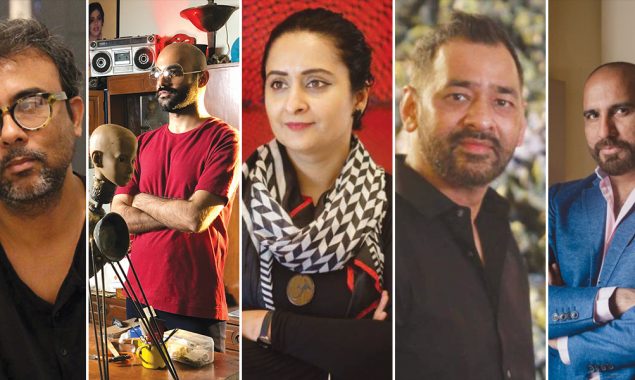Synopsis
When it comes to fine art, Pakistan has a lot of creatives whose work pushes on the boundaries of our industry, nationally and internationally!

- Adeel Uz Zafar

This Karachi born artist has developed his own intrinsic and unique way of art, setting his work apart from the rest. The artist completed his BFA degree at the prestigious National College of Arts, Lahore in 1998 and then took up the role of an illustrator before dedicating himself to painting. His prior work experience and his time in the remote district of Gilgit helped evolve his practice which features a distinct engraving method. In technique, the lack of materials in Gilgit led him to use photographic sheets and a cutter to create his imagery, whereas contextually, his insight as a children’s book illustrator translated itself onto his current works where childlike imagery is given a certain seriousness or gravity by being wrapped in bandages. Zafar tries to raise questions about identity and the delusion of individuality through the use of these bandages that warp the emblem of innocence. These ominous figures appear even more jarring when placed in front of a pitch-black backdrop to create sublime visuals. Zafar has exhibited his work extensively within the country as well as internationally including several fairs such as Art Stage Singapore, India Art Fair and Pulse Art Fair, New York.
- Rashid Rana

Rana is a Lahore-born artist who constantly pushes on Pakistan’s socio-political boundaries through contextually challenging works of art, leaving viewers questioning their own conditioned perceptions. Widely considered to be the foremost Pakistani artist of his generation, the artist has an internationally lauded oeuvre. His works are housed in many prestigious collections including the British Museum in London, the Metropolitan Museum of Art in New York, and other establishments worldwide. Trained originally as a painter at the NCA in Lahore, he was a student of Zahoor-ul-Akhlaq, followed by a Masters at Massachusetts College of Art, Boston. He is also a founding faculty member and currently the Dean of the School of Visual Arts and Design at BNU, Lahore. The artist constantly pushes boundaries not only in the peripheries of identity politics, but also amidst the boundaries of what we call art. His famed mosaic series showcased works constructed with micro images that make up a larger macro image, combining two conflicting ideas, one pertaining to societal norms and the other actively challenging the former. It not only subverts the perspectives of the viewer, but asks each person to re-evaluate their realities as they move between the macro and micro elements of what they are seeing. At the end of the day, the artist and his work furthers ones opinions and what they think to be the truth versus what is the actual truth.
- Imran Qureshi

A master of the art of neo-miniature, Imran Qureshi reworks the painting style typical of Mughal courts in the 16th to 19th in a more contemporary manner. His art divulges already existing techniques and turns them into something quite unique and distinct in nature. Born in Hyderabad, the artist has been exhibiting locally and internationally for almost twenty- five years. He studied miniature painting at the National College of Arts in Lahore, where he now teaches the same discipline. Considered one of Pakistan’s most important artists, he has received international recognition for his site-specific installations that respond to architectural space, referencing the historical or political significance of the buildings that contain them. Crosshairs, fingerprints and flecks of red like spattered blood, patterned beauty of flowers and feathers, the artist’s work is as gestural as it is meticulous. A practice of showering a location or a canvas with blood-like elements, then moving in close to depict ornate floral or natural imagery is one of his more classic techniques. Since 1997 his work has appeared at biennials in Bangladesh, Sharjah, Singapore and Sydney, and has been featured in solo exhibitions at galleries and museums in cities in New York, London, Hong Kong and Mumbai, and in cities across his native Pakistan, including the Metropolitan Museum of Art.
- Aisha Khalid

A pioneer in the neo-miniature movement, Khalid has effortlessly advanced herself to become one of the most significant artists of her day. Her work often tends to embark dramatic elements of geometric patterns that aim to engage conversations of power dynamics that not only depict or subvert realities of our era, but also represent one’s search for spirituality. Having grown up in Shikarpur interior Sindh, Khalid’s worldview is deeply rooted in the history of the East and her constant efforts to incorporate such perspectives reflects into her work. Aisha Khalid remains one of the most prominent contemporary artists from Pakistan, and also works as curator and art educationist. She graduated from National College of Arts, Lahore, in 1997 and received her post-graduate degree at Rijksakademie, Amsterdam, in 2002. Having received her formal training as a miniature painter, she soon sought to venture beyond the peripheries of traditional miniature practice. She has participated in solo and group exhibitions nationally and internationally and her works are exhibited in several museum and private collections all over the world, such as Aga Khan Museum Toronto, Fukuoka Asian Art Museum Japan, Sharjah Art Museum, Queensland Art Gallery, Sheikh Zayed Museum and World Bank.
- Affan Baghpati

Born in 1991 in Karachi, Affan Baghpati completed his undergraduate studies in Fine Arts from Indus Valley School of Art and Architecture where he is currently a lecturer. His practice is quite different from his comrades, where the artist collects discarded domestic objects of utility, ornamentation and figurines, and re-contextualises their purpose. These discarded objects, often from different cultures that may have already lost their function, are collected by the artist and find themselves in an entirely new interpretation of their form. Baghpati draws hybrid connections amongst these found objects, repurposing them through their design, form and functionality. Through his art practice, he aims on bringing his viewers closer to the intimacy of these objects that were once functional in Pakistani households. His recent work includes installations using taxidermy, discarded furniture, metal artifacts and jewellery. Baghpati has showcased his works at several national and international galleries including AAN Gandhara, Sanat initiative, Rohtas 2 gallery in Pakistan, and establishments in Milan, New York, Philadelphia and Dubai. His works were also part of several biennales including Karachi Biennale, Lahore Biennale, Beirut Art fair, and India Art Fair.
Read More News On
Catch all the Entertainment News, Breaking News Event and Latest News Updates on The BOL News
Download The BOL News App to get the Daily News Update & Follow us on Google News.




